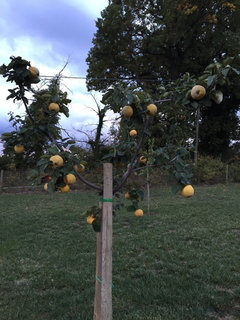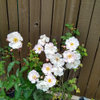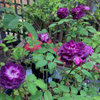(OT) Quince
Melissa Northern Italy zone 8
8 years ago
Featured Answer
Sort by:Oldest
Comments (27)
monarda_gw
8 years agoRelated Discussions
OT Fall is my favorite season - how about you?
Comments (33)In Northern California on vacation just now, I saw Icebergs in full bloom and my mother's Marie Pavie (a cutting from mine!) blooming away with such perfect form and scenting the air around her. On return home, everything is frozen, grey and brown. What a downer. At work people were telling me that they knew I was in a bad mood. Well, duh. I was snarling at everyone. So the start of winter is the worst. By January, I usually come to acceptance. It's the Kubler-Ross stages of grief every #*$&(*% year. Sigh. Denial: "It's not that bad. It won't be that bad. It's actually beautiful in the winter." (October) Anger: "I hate this f***ing place! Why do we have to live here?!" (November-December) Bargaining: "Can we just PLEASE move somewhere with a year-round growing climate? Please, please, please...?" (December) Depression: "Maybe if I just eat enough chocolate I will get enough phenylethylamine to get through." (December, and 20 pounds of chocolate later...) Acceptance: "Well I may as well get chores done and dream of beautiful gardens." (January/February...if I'm lucky). Then the winds come in March/April the new growth gets ripped to shreds, and I start all over again....See MoreOT/A little bit of spring happiness waiting on my roses!!
Comments (18)Hyacinths usually last at least a week and sometimes longer. The regular ones have such short stems it's kinda hard to deal with but I have another variety I like the most that has looser blooms and longer stems but don't know the varieties name. Thanks a bunch bustopher....See MoreOT I love The First Signs Of Spring....
Comments (1)Love it Laura. Used to have that one at our first home...when do you start THE MARCH?...See MoreOT - How is everyone doing?
Comments (17)Julia: So sorry to hear about the postponement for surgery. It may be a blessing in disguise with the hospitals packed with Coronavirus patients (or not)....... Debra: I hope you get well quickly and if in doubt have yourself tested. I read today that Tom Hanks said that all he feels from having the virus is kind of "blah". Hopefully that's all anyone will feel if they contract it...........Brad: What a hoot on "stalking the wild toilet paper roll". Nan: May everyone recover and your son's business weather the storm. It's absolutely crazy to see what's happened in the blink of an eye. Why people bought up all the toilet paper for a virus that is respiratory in nature caught me off guard. This isn't the green apple two step flu.........I was just bringing out my small pots of daylilies I've overwintered in the garage, when they said we will have a low Friday night of 28. Yo Yo weather indeed....... BTW. We are like everyone else on supplies. I'm wondering where my Sears & Roebuck catalog might be.............Maryl...See Morefduk_gw UK zone 3 (US zone 8)
8 years agostillanntn6b
8 years agonikthegreek
8 years agotuderte
8 years agonikthegreek
8 years agonikthegreek
8 years agolast modified: 8 years agotuderte
8 years agonikthegreek
8 years agolast modified: 8 years agomustbnuts zone 9 sunset 9
8 years agonikthegreek
8 years agolast modified: 8 years agomustbnuts zone 9 sunset 9
8 years agoparker25mv
8 years agolast modified: 8 years agoAquaEyes 7a NJ
8 years agoMelissa Northern Italy zone 8
8 years agonikthegreek
8 years agolast modified: 8 years agoMelissa Northern Italy zone 8
8 years agonikthegreek
8 years agoMelissa Northern Italy zone 8
8 years agonikthegreek
8 years agoMelissa Northern Italy zone 8
8 years agotuderte
8 years agonikthegreek
8 years agolast modified: 8 years agoMelissa Northern Italy zone 8
8 years agonikthegreek
8 years agotuderte
8 years ago
Related Stories

FEEL-GOOD HOMESimple Pleasures: Make Do and Mend
Experience the satisfaction of fixing, repurposing and creating things yourself around the home
Full Story






tuderte